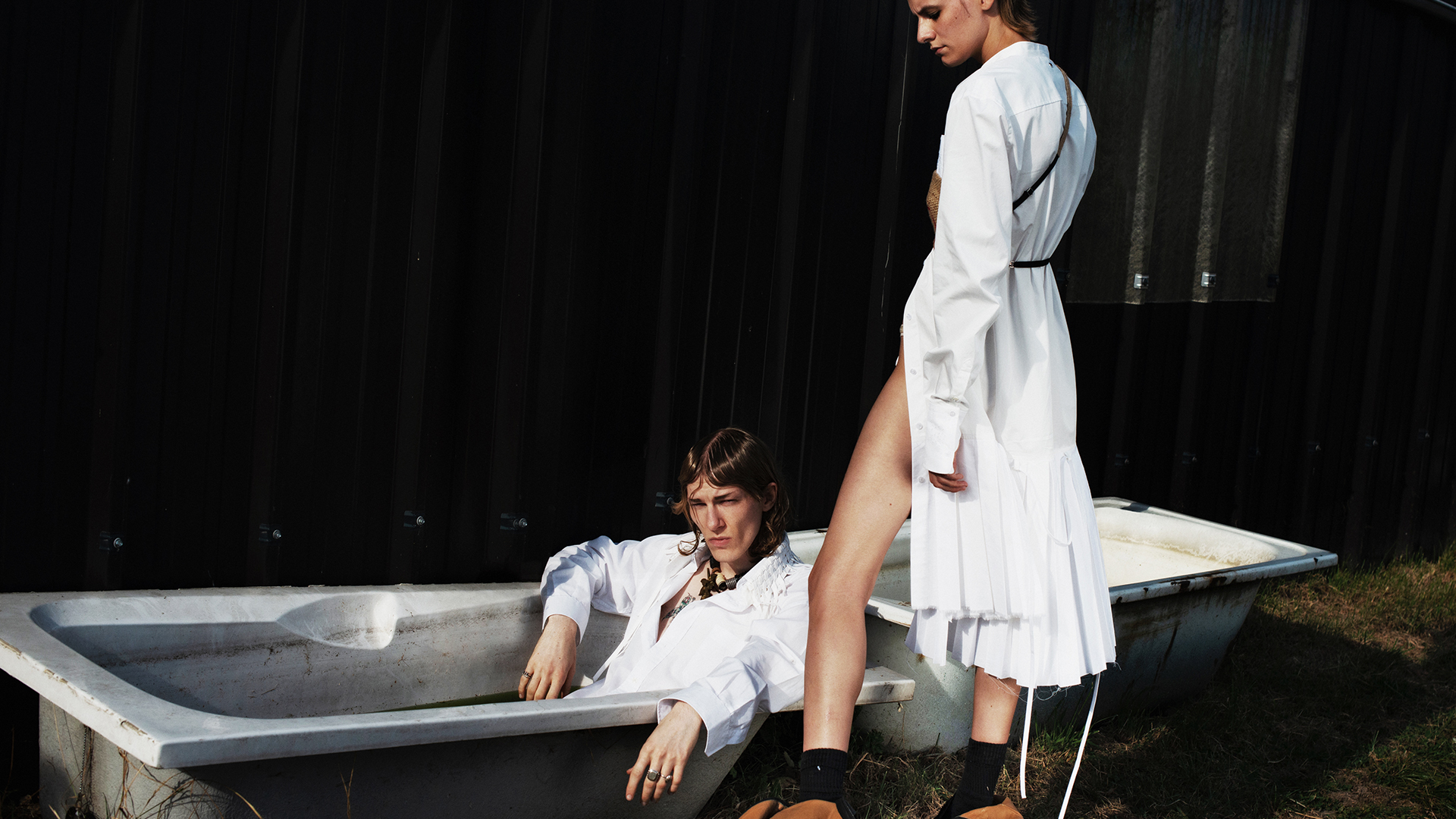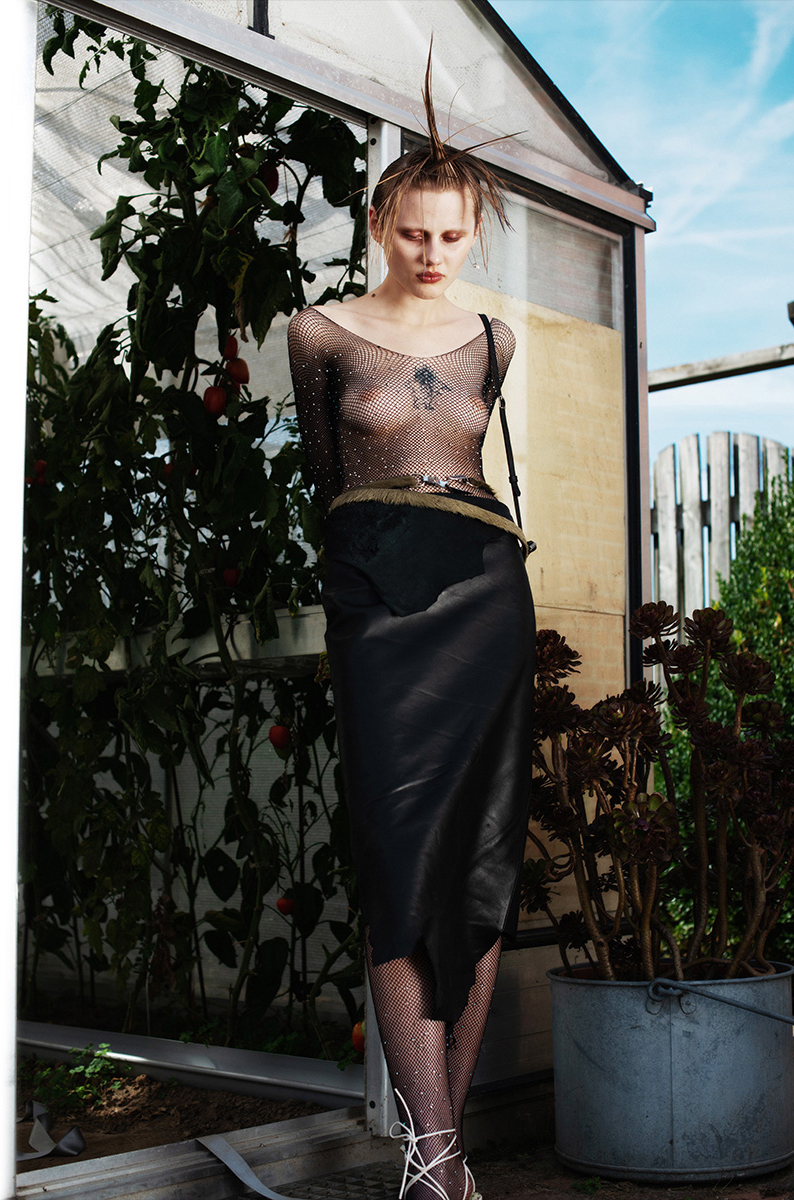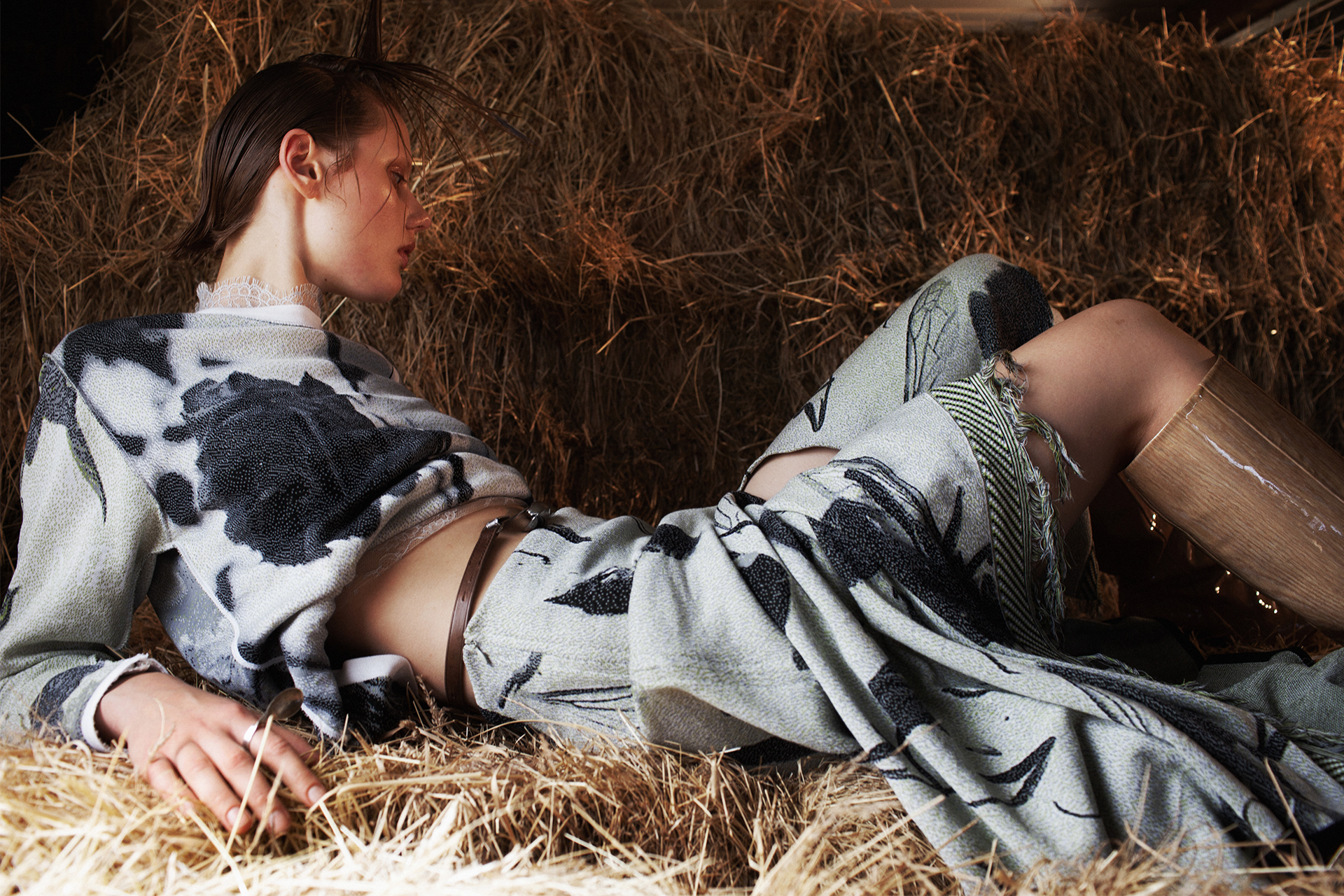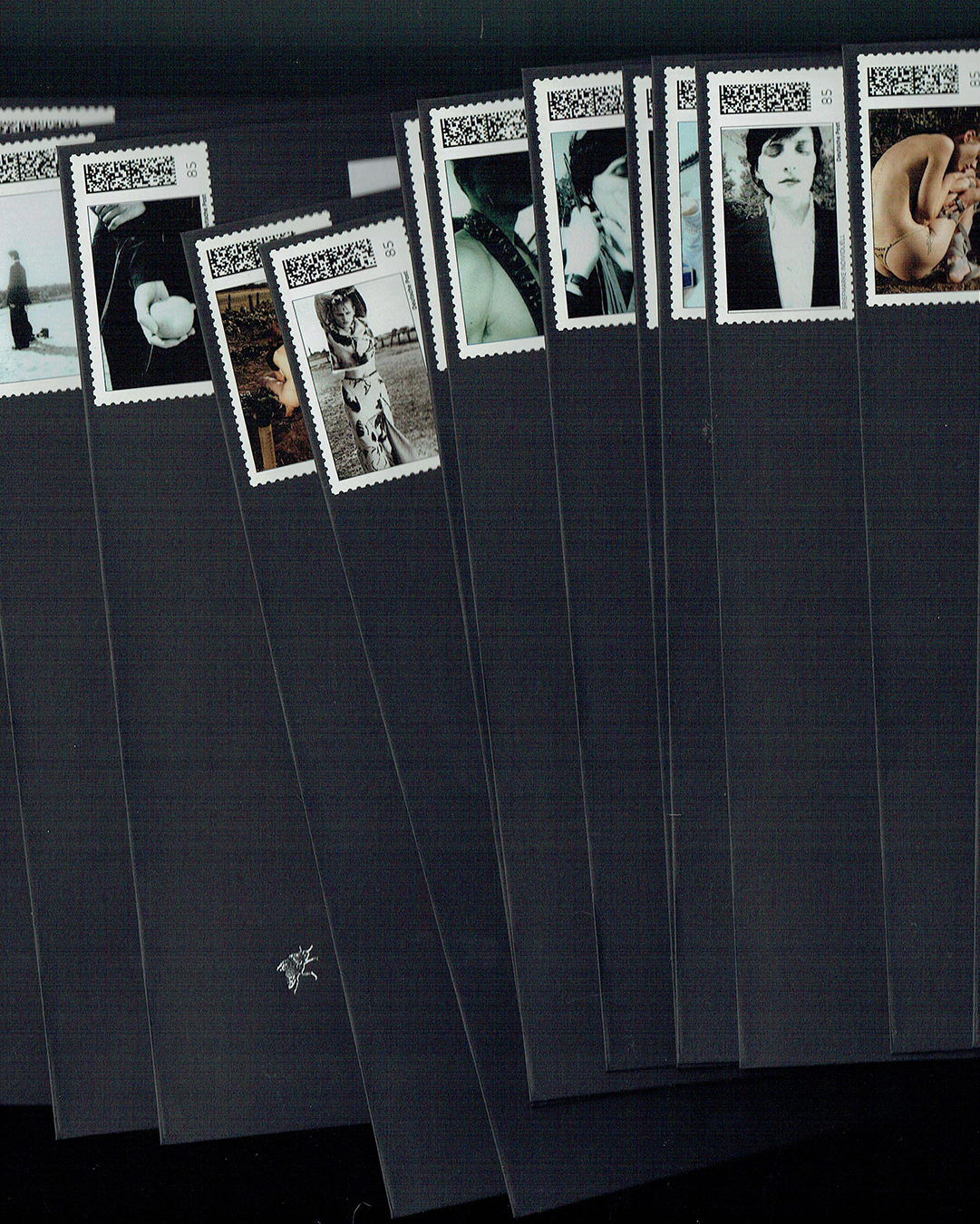Clothes for someone who ‘goes to hardcore concerts but is also a wine-maker’

A newcomer to the fashion scene that possess wisdom way beyond its years, Milk of Lime is the enigmatic brand you should put on your radar. Finding solace in a far-flung town in South-West Germany, Julia Ballardt’s and Nico Verhaegen’s biggest muse is their natural surroundings – and the organically occurring oddities that inform their spellbinding graphics, colour palettes, and confident silhouettes. The brand finds its own grounding beyond the standard practices of the fashion industry, by honouring and surrendering to nature, which is seen in their special drops every full moon. Weaving poetry into each of their pieces, Milk of Lime’s designer language is astute and moves at its own pace – calmly yet fiercely, resembling natural forces themselves. In light of July’s full moon, we spoke to the artists about nurturing their young brand from the ground, sustainability as a buzzword, and their biggest-to-date upcoming show in Berlin.
Hey, great to speak to you! Let’s start in the beginning – how did Milk of Lime come to life?
Nico: Julia and I studied together in Antwerp at the Royal Academy. We got along pretty well, and then moved to Paris together to work for Givenchy. At one point, our contract ran out and we moved to a town in the middle of nowhere in the West Germany.
Julia: It’s really not a fashionable area to be in. But this is where we are today, and we also found some producers here. We’re only a year old, but it’s nice to be connected here.
N: For us, it’s very important that we live first and create second. It was about doing what you love in a place that you love.
The connection with nature seems to be a very palpable point of inspiration within your work. Can you tell me more?
Julia: It is very important to be in a place that inspires you. For us it’s actually being in nature – it’s something you can’t Google. You can have a walk and see this rotting flower with a strange colour combination – these are the things that happen by chance and not by looking for it. It sounds a bit poetic and romantic, but we have this abandoned concrete factory not too far from us, and they have all these rusty nails and concrete washed down by rain into different colour palettes.
Nico: you also have all the flower fields, vineyards and so on… Very good shoot locations around! We like to do everything ourselves – of course, it’s also great to collaborate with photographers but sometimes you want to shoot a look, and then there is just the best location around the corner.
Julia: We used to live in a city with all these opportunities, but in a tiny space where there is no room to create. You have access to everything but no space to put a sewing machine. There are, of course, a lot of challenges we’re still facing now: I can’t just quickly go to a supply store because I’m missing a thread of a certain colour. Still, we set our priorities, and the countryside was the right choice for us, as it gives us the possibilities we value.

Tell me about your moon jumpers and what doing a drop every full moon means to you!
Julia: We needed to figure out a plan of how to navigate our brand. There is a lot of fashion out there, and we wanted to find something that was genuine to us, but also something new for the spoiled eye of our audience, ha-ha. It was interesting for us because it was like an alternative calendar – not a fashion calendar, but a moon one. It was an intuitive choice for us to also keep working to avoid this big chunk of silence in between gigantic collections. It gave us a reason to create frequently.
Nico: I also think there is something very grounding about basing your practice around what is happening anyway. Fashion week is something that is decided by someone, but the moon will be there whether you like it or not.
How is this manifested in the materials you turn to?
Nico: First and foremost, we work with natural materials. In particular, deadstock – we have sources from which we get leftover fabrics from LVMH, like their silks, wools, cottons. We also have a connection in Belgium who sources deadstock leather from North Italy. He buys a palette of Hermès or Gucci leather where there are some pieces cut out, but we can still create belts or bags from it.
Julia: For them, it’s too small to do a series, but for us it’s ideal – the quality is of a certain standard and the price is fair. Our leather manufacturer is only one and half hours away and we have this certain friendship, so we get leftovers from his other productions as well. It’s a bit of a dream scenario, but also something we’ve had to nourish as well – it only exists because there is a certain trust we’ve built.
Nico: It’s this weird artisanal way of approaching circularity. It’s a very time-consuming form of it, but it pays off.
Definitely, and also reflects your ethos of producing sustainably and honourably.
Julia: Well, this is not the answer to sustainability. To be honest, I’m not a big fan of this word. I think it’s just something we should naturally be busy with – thinking about what our actions lead to. You should just establish what your values are as a designer. I don’t appreciate plastic in clothing, on my skin, or the environment, so I’m staying away from it. Of course, there are also downsides to cotton and leather – and you can argue about that as well. But we took a decision, and we do the best that we can within that. We use real leather, but it’s leather that would be discarded anyway.
Nico: For me, the most sustainable piece you can have is a jacket that you wear for ten years, and it can last for ten more. With natural materials, they don’t break over time – they break in, they get more and more character. They grow and age with you.
Sustainability is becoming such a buzzword – it’s so overused and shoved down our throats that the actual meaning behind it gets so muffled. It comes across different with Milk of Lime – you’re only one year old, but your identity feels so established.
Julia: Thank you, it’s very nice to hear from the outside! When you’re in it, you’re just trying to do it the best that you can, and you lose a sense of how it would be perceived on the outside.
Within this journey, what have some your proudest moments been?
Nico: For me, the proudest moment was when received a piece from the factory for the first time. We make most of our samples in-house, so giving trust to an external factory and then receiving this perfect product back was such a proud moment.
Julia: It made it feel real also – it felt like you’re this little company that can do these things and achieve a certain level of professionality. In the process of starting a label professionally, I think it’s more these internal victories that you really feel. You don’t really share them with the outside.
Nico: It’s also super nice to get beautiful photos back from stylists. There is a shoot that’s going to be published soon, and the photos turned out so great. It’s such a big moment of ‘wow, this is what our pieces look like?’
Julia: It’s beautiful when someone manages to interpret them in their own way, but it’s still a complement towards you as well. There is a certain understanding and poetry about it.

Is there a particular way you’d like your wearer to feel in your clothes?
Nico: We design around this fictional character who goes to hardcore concerts, but they’re also a wine-maker and read poetry. They are quite a weird character, but if I should say anything, I’d say I’d like people to feel poetic wearing Milk of Lime.
‘Poetic’ seems to be a descriptive that has come up a lot in this conversation…
Julia: Poetic can have very different facets. I want people to feel, just in general – for them to talk to each other, to fill words with meaning again. I have a picture here of Ann Demeuleeester and Patti Smith right here, and I miss this sensuality about clothes. It should also be about not the clothes wearing you, but you wearing the clothes in a way through which they underline your personality.
What’s on the horizon for Milk of Lime?
N: The first thing coming up is the runway show, and then we also have the showroom. It’s the first time we’re showing something this big, there will be a lot of new things.
J: It’s also a new environment – Berlin is a bit of a new territory, but in a good way. We’ve been receiving a lot of support and meeting very warm people. I think all our focus is going to this event, but afterwards we can open up to new ideas again

Notifications